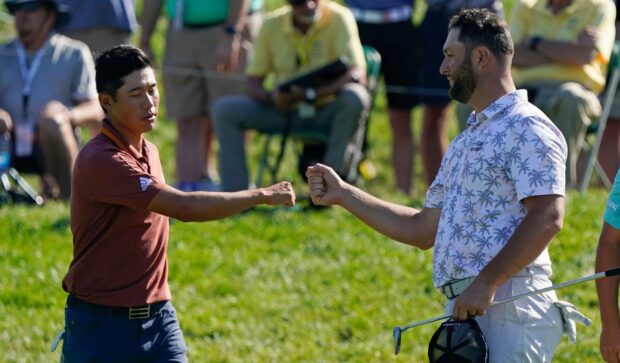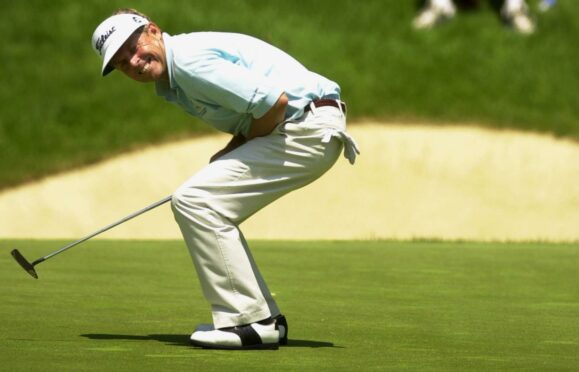Unlike lesser awards, Tee to Green’s annual Player of the Year encompasses the entire year. Thus it is far more representative than the PGA Tour Player of the Year, which was decided in October.
The winner of that for 2021, apparently as voted by his peers, was Patrick Cantlay. For me, this is the biggest miscarriage of justice in this particular award since the first time they voted, in 1990.
Then, of course, Nick Faldo was the undisputed World No 1. He’d recovered the Claret Jug at St Andrews that year, just a three months after helping himself into the Green Jacket at Augusta, being the winner for the second year in a row.
In addition, he was one shot out of the play-off for the US Open at Medinah, won by Hale Irwin.
The PGA Tour Player of the Year that year, however, was Wayne Levi.
Now Levi did win four events on the tour that year (he never won again after that year) so he has a case. But he qualified for just two majors (he never once played the Open) and missed the cut in both.
On my not-particularly-statistically-valid measuring method, a major counts for three tour wins. Faldo should have got the Jack Nicklaus Award (as it is named) in 1990.
It usually goes to the right man
From 1990 to 2020, the PGA Tour Player of the Year generally went to the right man – 11 times to one Eldrick Tont Woods of Jupiter, Florida, for example. There’s been a few close run things. But none as wrong as this year’s, I feel.
Insane stat of the day: Jon Rahm lost to 13 of the 552 golfers he faced at the majors this season. He beat or tied 97.6% of his competition.
— Kyle Porter (@KylePorterCBS) December 9, 2021
Cantlay, like Levi, won four times this year, and carried off the FedEx Cup as well. But as much as the Jay Monahan and the Tour desperately wants us to consider this even remotely close to the pinnacle of the sport, it really isn’t.
There are two main contenders for this year’s T2G player of the year title, and neither are Cantlay.
Jon Rahm of Spain ended the year, comfortably, as World No 1. His only actual win on the year was his US Open victory at Torrey Pines in June, a victory I think we were all expecting.
Rahm was of course clearly denied a win in the event prior to that. He had a dominating – probably insurmountable – lead at Jack Nicklaus’ Memorial Tournament, when he had to withdraw because of a positive Covid test. That was one of just four events he didn’t finish all four rounds during the year.
His major record? T5-1st-T3-T8.
Now I have some sympathy with the voice from the back saying the majors are too important and there’s other golf to consider. But a season with a worst finish in the four very different, most challenging set-ups and quite clearly the most important events played counts for a great deal.
While Rahm didn’t win elsewhere (although he actually won the Tour Championship if was played to proper rules), he was top 10 13 times in 21 starts. There’s a reason he has almost a point lead in the OWGR.
The best young player of the moment
Watch @collin_morikawa prove just how insanely accurate his 6-iron is. 🤯 https://t.co/NjBB59e1KV
— Golf Digest (@GolfDigest) December 11, 2021
Coming up fast, however, is World No 2 Collin Morikawa. The California-born, Las Vegas-based player underlined this year that putting aside the suffocating hype surrounding Bryson Biceps. There’s really no discussion as to who is the best young player of the moment.
Morikawa’s steely final day at The Open was possibly the most impressive single performance of 2021. With a quality field alongside or just behind him, he never gave them as much as a glimpse he might be beaten.
Earlier in the year, he captured the WGC-Workday Championship. Although those WGC titles seem likely to lapse into historic irrelevance now, they were often the best fields outside the majors.
And Morikawa finished the year with a flourish, winning the Race to Dubai and the DP World Championship in imperious fashion.
An enormous cop-out, but…
To be honest, I can’t separate the two. Both played superbly at the Ryder Cup. Morikawa was the lead American qualifier, was unbeaten as a rookie and clinched the winning half point. Rahm played all five rounds and won four – nearly half Europe’s points on the entire weekend.
Morikawa’s probably got the edge on events won. Rahm has it on consistency and resilience, which counts for a lot at T2G Towers.
It’s an enormous cop-out, I admit, but if we had a trophy to lift, they’d get one handle each.
But the biggest achievement of 2021 was…
Huge CONGRATULATIONS as 2021 @SolheimCupEuro @LETgolf awarded AGW 'Golf Writers' 🏆following their stunning @TheSolheimCup success
Captain Catriona Matthew @Beany25 “It is an amazing honour to win the Golf Writers’ trophy… & pleasing for it to be recognised by AGW members" pic.twitter.com/5OPiLnBWSD
— Association of Golf Writers (AGW) (@AGWgolfwriters) December 13, 2021
The Association of Golf Writers Trophy – which does exist although it has no handles – attracted the biggest vote ever (it dates from 1951). Such are the wonders of email replies and our tenacious secretary and Crail Golfing Society stalwart, Bernie McGuire.
We voters in the AGW we can be happily parochial in considering only players based, born or representing Europe. The winner(s) for 2021, by a landslide, were Catriona Matthew and her Solheim Cup team.
This was a complete no-brainer, even in a year when Rahm performed so well. I don’t think that we’ve adequately realised or acknowledged the historic nature of that achievement yet.
“Beany” is the first to play on and captain winning teams home and away in the Ryder or Solheim Cups. That’s gobsmacking, when you stop to consider it.
They honoured her in North Berwick by naming a lounge in the historic clubhouse after her last week. It’s surely the first of a deluge of honours for this most modest and under-stated of Scottish golfing superstars.

